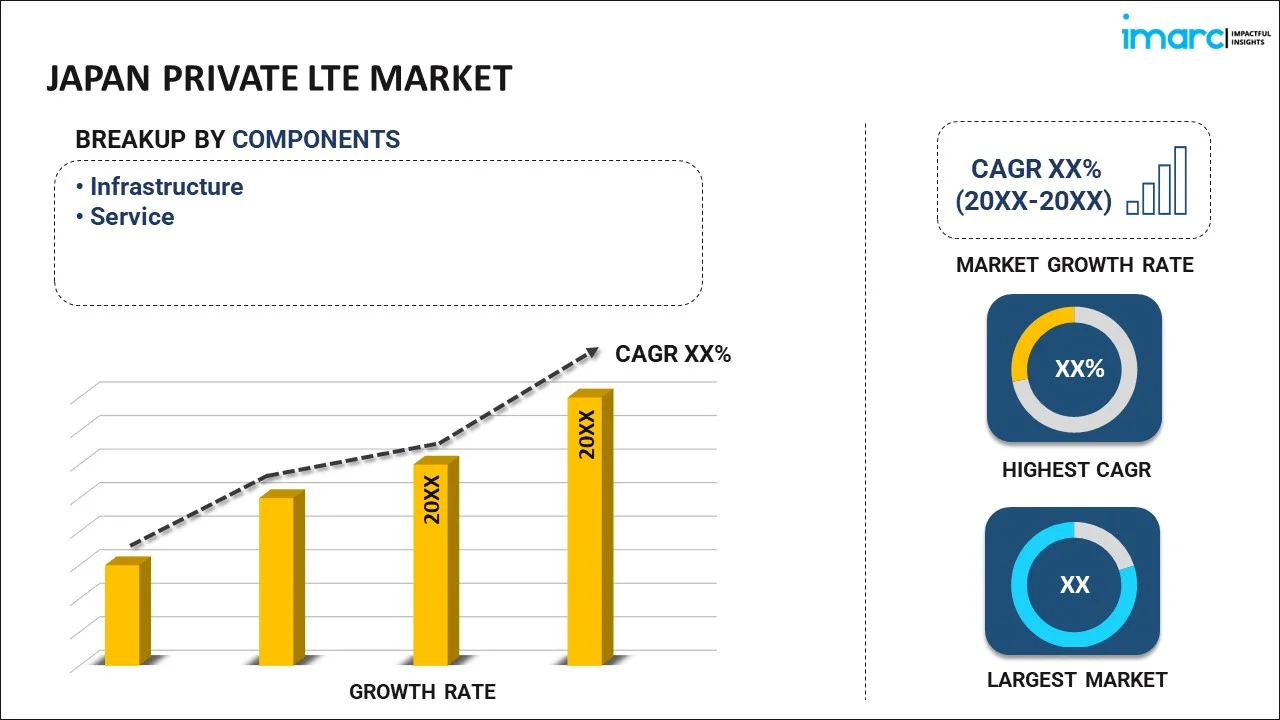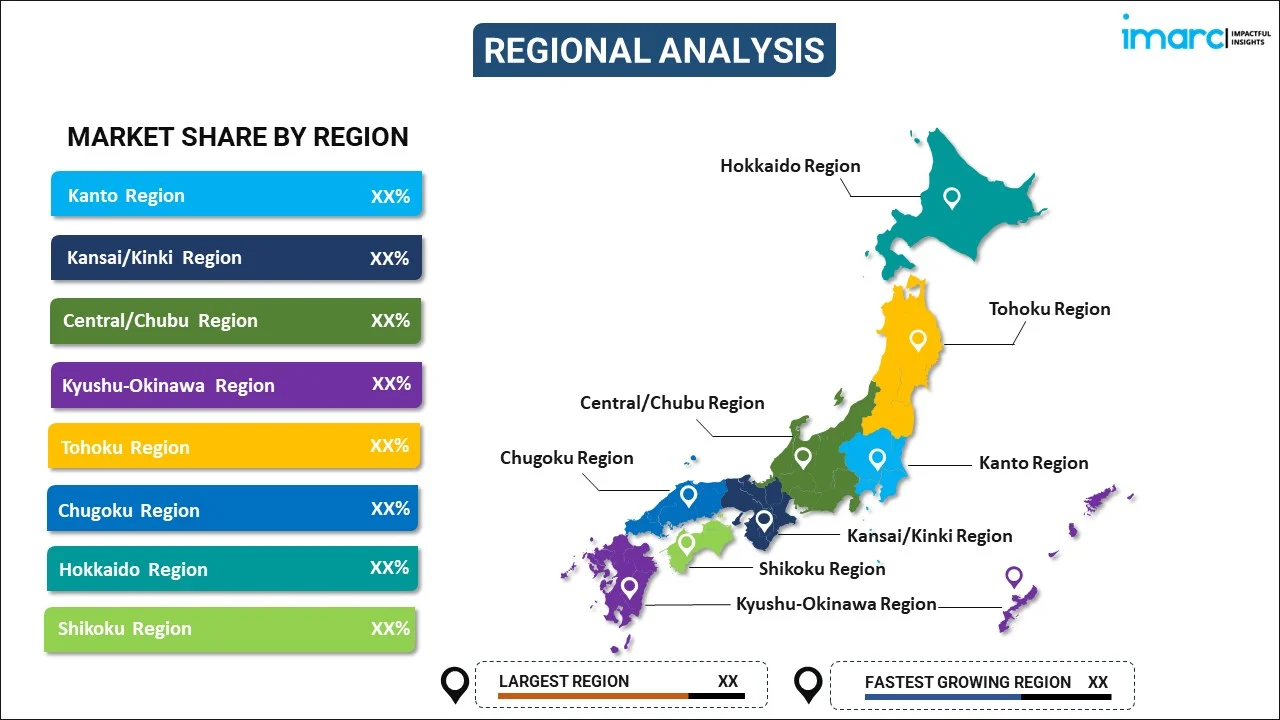
Japan Private LTE Market Report by Component (Infrastructure, Service), Technology (FDD, TDD), Frequency Band (Licensed, Unlicensed, Shared Spectrum), Deployment Model (Centralized, Distributed), Industry Vertical (Healthcare, IT and Telecom, Manufacturing, Retail and E-commerce, Government and Defense, Government and Defense, Oil and Gas, Education, and Others), and Region 2026-2034
Market Overview:
Japan private LTE market size reached USD 401.0 Million in 2025. Looking forward, IMARC Group expects the market to reach USD 1,259.7 Million by 2034, exhibiting a growth rate (CAGR) of 13.56% during 2026-2034. The increasing demand for applications like augmented reality (AR), virtual reality (VR), and autonomous vehicles that require low-latency networks, is primarily driving the market.
|
Report Attribute
|
Key Statistics
|
|---|---|
|
Base Year
|
2025 |
|
Forecast Years
|
2026-2034
|
|
Historical Years
|
2020-2025
|
| Market Size in 2025 | USD 401.0 Million |
| Market Forecast in 2034 | USD 1,259.7 Million |
| Market Growth Rate (2026-2034) | 13.56% |
Private LTE (long-term evolution) is a wireless communication network technology that operates on the same fundamental principles as traditional LTE but is deployed for exclusive use by a specific organization or entity. These networks are tailored for dedicated, secure, and high-performance connectivity within a closed environment. Private LTE offers several advantages, including reliability, low latency, and high data throughput, making it suitable for various industries such as manufacturing, healthcare, transportation, and agriculture. These networks are often used to support mission-critical applications like industrial automation, remote monitoring, and real-time communication. Key features of private LTE networks include control over spectrum allocation, enhanced security measures, and the ability to customize network configurations to meet specific requirements. These networks can operate independently or be integrated with existing infrastructure. Additionally, private LTE serves as a steppingstone toward the adoption of 5G technology, enabling organizations to prepare for the future of wireless communication while maintaining control over their network's performance and security.
Japan Private LTE Market Trends:
The private LTE market in Japan is experiencing rapid growth, primarily driven by several key factors. To begin with, the increasing demand for secure and reliable wireless communication networks is a pivotal driver. As organizations seek to enhance their operational efficiency and data security, they are turning to private LTE solutions as a robust option. Moreover, the proliferation of Internet of Things (IoT) devices in various industries is another significant catalyst for market expansion. Private LTE networks offer the low latency and high bandwidth required to support the vast number of connected devices in applications like smart manufacturing and smart cities. Apart from this, the rising trend of Industry 4.0 is contributing to the surge in private LTE adoption. Manufacturers are embracing automation and advanced robotics, necessitating robust communication infrastructure that can handle real-time data transmission and control. Additionally, the increasing emphasis on digital transformation in sectors such as healthcare and transportation is expected to drive the private LTE market in Japan, as they provide the necessary connectivity for telemedicine, autonomous vehicles, and other emerging technologies.
Japan Private LTE Market Segmentation:
IMARC Group provides an analysis of the key trends in each segment of the market, along with forecasts at the country level for 2026-2034. Our report has categorized the market based on component, technology, frequency band, deployment model, and industry vertical.
Component Insights:

- Infrastructure
- Service
The report has provided a detailed breakup and analysis of the market based on the component. This includes infrastructure and service.
Technology Insights:
- FDD
- TDD
A detailed breakup and analysis of the market based on the technology have also been provided in the report. This includes FDD and TDD.
Frequency Band Insights:
- Licensed
- Unlicensed
- Shared Spectrum
The report has provided a detailed breakup and analysis of the market based on the frequency band. This includes licensed, unlicensed, and shared spectrum.
Deployment Model Insights:
- Centralized
- Distributed
A detailed breakup and analysis of the market based on the deployment model have also been provided in the report. This includes centralized and distributed.
Industry Vertical Insights:
- Healthcare
- IT and Telecom
- Manufacturing, Retail and E-commerce
- Government and Defense
- Energy and Utility
- Oil and Gas
- Education
- Others
The report has provided a detailed breakup and analysis of the market based on the industry vertical. This includes healthcare, IT and telecom, manufacturing, retail and E-commerce, government and defense, government and defense, oil and gas, education, and others.
Regional Insights:

- Kanto Region
- Kansai/Kinki Region
- Central/ Chubu Region
- Kyushu-Okinawa Region
- Tohoku Region
- Chugoku Region
- Hokkaido Region
- Shikoku Region
The report has also provided a comprehensive analysis of all the major regional markets, which include Kanto Region, Kansai/Kinki Region, Central/ Chubu Region, Kyushu-Okinawa Region, Tohoku Region, Chugoku Region, Hokkaido Region, and Shikoku Region.
Competitive Landscape:
The market research report has also provided a comprehensive analysis of the competitive landscape in the market. Competitive analysis such as market structure, key player positioning, top winning strategies, competitive dashboard, and company evaluation quadrant has been covered in the report. Also, detailed profiles of all major companies have been provided.
Japan Private LTE Market Report Coverage:
| Report Features | Details |
|---|---|
| Base Year of the Analysis | 2025 |
| Historical Period | 2020-2025 |
| Forecast Period | 2026-2034 |
| Units | Million USD |
| Scope of the Report | Exploration of Historical Trends and Market Outlook, Industry Catalysts and Challenges, Segment-Wise Historical and Future Market Assessment:
|
| Components Covered | Infrastructure, Service |
| Technologies Covered | FDD, TDD |
| Frequency Bands Covered | Licensed, Unlicensed, Shared Spectrum |
| Deployment Models Covered | Centralized, Distributed |
| Industry Verticals Covered | Healthcare, IT and Telecom, Manufacturing, Retail and E-commerce, Government and Defense, Government and Defense, Oil and Gas, Education, Others |
| Regions Covered | Kanto Region, Kansai/Kinki Region, Central/ Chubu Region, Kyushu-Okinawa Region, Tohoku Region, Chugoku Region, Hokkaido Region, Shikoku Region |
| Customization Scope | 10% Free Customization |
| Post-Sale Analyst Support | 10-12 Weeks |
| Delivery Format | PDF and Excel through Email (We can also provide the editable version of the report in PPT/Word format on special request) |
Key Questions Answered in This Report:
- How has the Japan private LTE market performed so far and how will it perform in the coming years?
- What has been the impact of COVID-19 on the Japan private LTE market?
- What is the breakup of the Japan private LTE market on the basis of component?
- What is the breakup of the Japan private LTE market on the basis of technology?
- What is the breakup of the Japan private LTE market on the basis of frequency band?
- What is the breakup of the Japan private LTE market on the basis of deployment model?
- What is the breakup of the Japan private LTE market on the basis of industry vertical?
- What are the various stages in the value chain of the Japan private LTE market?
- What are the key driving factors and challenges in the Japan private LTE?
- What is the structure of the Japan private LTE market and who are the key players?
- What is the degree of competition in the Japan private LTE market?
Key Benefits for Stakeholders:
- IMARC’s industry report offers a comprehensive quantitative analysis of various market segments, historical and current market trends, market forecasts, and dynamics of the Japan private LTE market from 2020-2034.
- The research report provides the latest information on the market drivers, challenges, and opportunities in the Japan private LTE market.
- Porter's five forces analysis assist stakeholders in assessing the impact of new entrants, competitive rivalry, supplier power, buyer power, and the threat of substitution. It helps stakeholders to analyze the level of competition within the Japan private LTE industry and its attractiveness.
- Competitive landscape allows stakeholders to understand their competitive environment and provides an insight into the current positions of key players in the market.
Need more help?
- Speak to our experienced analysts for insights on the current market scenarios.
- Include additional segments and countries to customize the report as per your requirement.
- Gain an unparalleled competitive advantage in your domain by understanding how to utilize the report and positively impacting your operations and revenue.
- For further assistance, please connect with our analysts.
 Request Customization
Request Customization
 Speak to an Analyst
Speak to an Analyst
 Request Brochure
Request Brochure
 Inquire Before Buying
Inquire Before Buying




.webp)




.webp)












